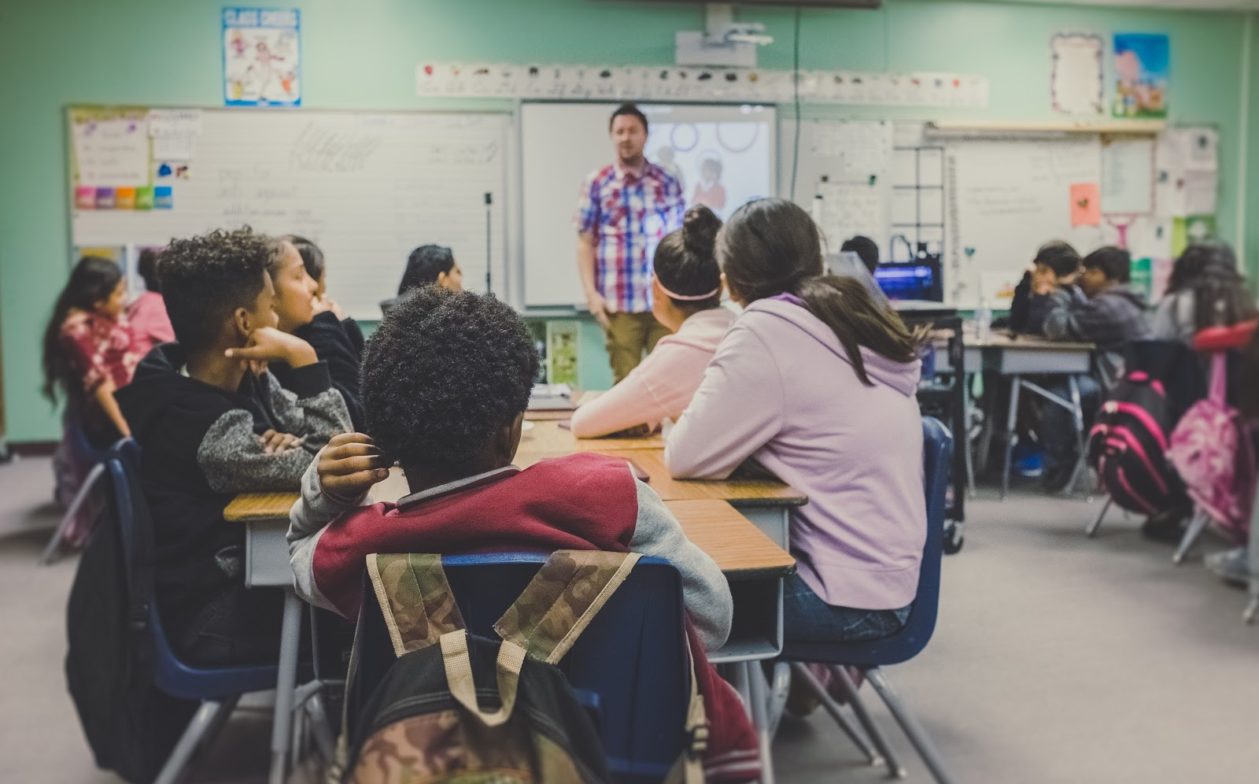In the United States, philanthropy plays a large role in shaping education, with investments meant to impact and make a change for future generations.
The racial divide, when it comes to education opportunities for students in the United States, has existed historically, and is now more amplified as a result of COVID-19. A recent study by EdBuild suggests that about 20 percent of students are enrolled in districts that are both poor and nonwhite, and stats show that just 5 percent of students live in white districts that are equally financially challenged.
The racial and economic disparities in schools provide a crisis at hand for future generations who will bear the brunt of the inequities as adults. Which is why it’s crucial now more than ever for philanthropists and investors to be part of the solution that could help remove those barriers and create more equitable school structures.

According to a study completed by the American Council on Education and funded by the TIAA Institute, in 2017, education received $412.26 billion, the second largest sector of philanthropic contributions in the United States.
America’s richest choose to invest in education because they believe that it will create change and have a positive impact in the world. Education is seen as an investment opportunity because it has the power to change the economic development and career opportunities for future generations.
While the philanthropic investment in American education is the second largest amount in comparison to other sectors, such as human resources, health and the environment/climate change, the contributions still pales when it comes to the overall spending of U.S. K-12 public schools per year.
Contributions from philanthropic organizations and funders are usually directed to influence policy change in education, to support teacher training and professional development, to improve learning efficacy and to support the creation of career pathways for students.
This begs the question: What are some of the major changes that have taken place over the past few years in education, and how can philanthropic organizations support schools and teacher leaders to build more equitable school systems across the U.S.?

There are several shifts and transformations that have developed over the past few decades, and funders and philanthropic organizations have contributed to shaping this transformation. One of the main shifts that education has seen is the digital transformation and the movement to a more digital education system.
This change has, of course, highlighted the digital divide amongst underserved communities. Philanthropy organizations, such as New Profit, work to ensure that underserved students, namely students of color, students from low-income households, students with disabilities and English language learners, are provided the same opportunities at success and excellence as everyone else.
Let’s take a closer look at some of the statistics and current facts about education in America in 2020. (These statistics do not reflect recent changes as a result of the COVID-19 pandemic.)
Numbers of Students Enrolled in Schools before September 2020:
- 50.7 million students attend public schools
- 5.7 million students attend private schools
Student Demographics:
- 23.4 million white students
- 14 million Hispanic students
- 7.6 million Black students
- 2.8 million Asian students
- 2.3 million students of two or more races
- 0.5 million American Indian/Alaska Native students
- 0.2 million Pacific Islander students
School Expenditures for 2020:
- $14,000: projected current expenditure per student in public elementary and secondary schools for the 2020–21 school year
- $709 billion: projected current expenditures for public elementary and secondary schools
Distance Education:
- 21 percent of all public schools offer any courses entirely online
Teachers in the United States:
There are expected to be about 3.7 million teachers in fall of 2020.
- 3.2 million teachers in public schools
- 0.5 million teachers in private schools
Shruti Sehra, a managing partner at New Profit, where she leads the education practice, discusses inequities that have been highlighted as a result of COVID-19. “With the rise of COVID, communities of color have been disproportionately impacted by the devastation surrounding it—both from a health and economic perspective,” Sehra says.
Investors and philanthropists’ support of leaders who are working on education solutions during this time to help alleviate the health and economic challenges that underserved communities are facing could make a big difference in ensuring people and communities don’t fall behind as a result of the pandemic.
One focus area that needs support in education is technology. “There are more and more relevant and meaningful education technology solutions that are ‘born digital’ rather than adaptations of existing analog innovations into digital ones,” Sehra says. She also explains that the majority of education technology historically has been created by technologists and innovators who are not in education or the classroom.
As a result, it is crucial more than ever for philanthropists and funders to ensure that when they’re investing in education solutions, they’re investing in people who have proximity to the communities facing the most acute challenges, the expertise for addressing them and knowledge of the systems themselves. This will ensure that the support, programs and any products they’re building solve relevant problems in education that are encountered by students and teachers.
Desmond Blackburn is a former superintendent and is now the CEO of New Teacher Center (NTC), a not-for-profit that works to disrupt the predictability of education inequities for systemically underserved students. Blackburn joined the organization in 2018 and has been immersed in working with superintendents and school leaders with high quality curriculum development and instruction that supports the social and emotional well-being of students and teachers.

“We work on behalf of systemically underserved children. Children living in poverty, English language learners, students with disabilities and Black and Latinx children,” Blackburn says. “The brutal reality is that these students are disproportionately not on the trajectory of living by anyone’s definition of the American dream.” The current education system is designed in a way where underserved communities aren’t provided with the same opportunities as white students.
There’s currently a $23 billion gap between the amount of money spent on predominantly white school districts and predominantly nonwhite school districts.
One of the regions NTC supports is a school district in California, focused on some of the challenges English language learners are encountering, especially as a result of COVID-19. NTC works to create synchronous and asynchronous teaching opportunities to support English language learner educators and created a 30-day support plan that puts an emphasis on emotional and social learning.
NTC also works with the Oakland Unified School District to create a multi-year approach to support, onboard and build the capacity of novice teachers.
“NTC’s mandate is working to support systemically underserved communities, and as a result of COVID-19, these inequities have been exacerbated,” Blackburn says. “The digital divide was alive and well before COVID-19, and now it’s even more real than before.” Students don’t have access to devices and internet access at home, along with many other barriers, and as a result, NTC’s focus has shifted to address these inequities, in addition to their mandate’s focus.
When asked about the challenges of fundraising in the education sector for an organization like NTC, Blackburn says that raising capital for an education organization is largely dependent on two factors: mission alignment and relational connectivity.
“Right now, there’s a great deal of efficacy and intent about inclusion and equity, and this will be more attractive to philanthropic support during this time,” Blackburn says. When an organization is aligned with the mission of inclusion and equity, there’s a great deal of appetite now from philanthropists to support such a mission, Blackburn explains.
When it comes to relational connectivity, that could pose a challenge for many new and upcoming organizations that have yet to build the relationships and networks to connect with these philanthropic support systems.
“Quite a bit of equity work in years past actually resulted in building greater inequities. While this was not true across the board, we know that the systemic gaps in funding equity in the social sector have led to advancement of a lot of leaders and organizations who are not, and do not work to make themselves, proximate to the communities they aim to serve,” Sehra says.
“As a sector, we rewarded quite a bit of well-intended efforts to support ‘those’ students, the ones who the system was not designed to support. In many cases, these efforts exacerbated inequities as a result of their lack of connection and deep understanding of the communities they were working with. What we’ve seen more of over the past few years is a transition from good leadership of interesting and innovative organizations to great leadership of the same organizations now led by leaders of color with the expertise born of proximity,” Sehra elaborates.
Sehra brings up important points about who philanthropists should continue to fund, and who they should focus their attention on instead. When philanthropists and funders are looking to invest in education, there are key questions to ask to understand the alignment of the mission, vision and mandate of the organization and who they’re aiming to serve.
Blackburn mentions the saviorism aspect of organizations that support educators and education, and he cautions against leaders coming in with a savior mindset to do this work and support underserved communities. “We’re not saviors of schools. We build education leaders up so that they can thrive on behalf of their children,” Blackburn says.
“Philanthropies are doing more and more to support organizations led with people who are in close proximity to the people served, and I believe this will continue to progress and increase—the future is bright,” Blackburn adds.
When philanthropists and funders are looking to invest in education to make a difference, it’s crucial that the equity and inclusion lens is used to understand and analyze the organizations and their leaders receiving those funds. In order to make an impact that will reduce inequities in schools and the school system, supporting those who truly understand, have lived experience and have worked directly on the frontlines of education will be a step in the right direction.
Join us for the second session of our Rearchitecting the Future Through Philanthropy and Social Entrepreneurship Series: Using a New Lens to See and Invest in Transformative Change in Education on Wednesday, Oct. 7, at 3 p.m. ET.







